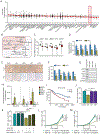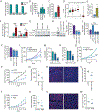GCN2 inhibition sensitizes arginine-deprived hepatocellular carcinoma cells to senolytic treatment
- PMID: 35839757
- PMCID: PMC9357184
- DOI: 10.1016/j.cmet.2022.06.010
GCN2 inhibition sensitizes arginine-deprived hepatocellular carcinoma cells to senolytic treatment
Abstract
Hepatocellular carcinoma (HCC) is a typically fatal malignancy exhibiting genetic heterogeneity and limited therapy responses. We demonstrate here that HCCs consistently repress urea cycle gene expression and thereby become auxotrophic for exogenous arginine. Surprisingly, arginine import is uniquely dependent on the cationic amino acid transporter SLC7A1, whose inhibition slows HCC cell growth in vitro and in vivo. Moreover, arginine deprivation engages an integrated stress response that promotes HCC cell-cycle arrest and quiescence, dependent on the general control nonderepressible 2 (GCN2) kinase. Inhibiting GCN2 in arginine-deprived HCC cells promotes a senescent phenotype instead, rendering these cells vulnerable to senolytic compounds. Preclinical models confirm that combined dietary arginine deprivation, GCN2 inhibition, and senotherapy promote HCC cell apoptosis and tumor regression. These data suggest novel strategies to treat human liver cancers through targeting SLC7A1 and/or a combination of arginine restriction, inhibition of GCN2, and senolytic agents.
Keywords: GCN2; arginine; hepatocellular carcinoma; senescence; urea cycle.
Copyright © 2022 Elsevier Inc. All rights reserved.
Conflict of interest statement
Declaration of interests M.C.S. is a member of the Cell Metabolism advisory board.
Figures







Comment in
-
Making liver cancer cells go ARGh!EMBO J. 2022 Nov 2;41(21):e112415. doi: 10.15252/embj.2022112415. Epub 2022 Oct 12. EMBO J. 2022. PMID: 36222348 Free PMC article.
References
-
- Abou-Alfa GK, Qin S, Ryoo BY, Lu SN, Yen CJ, Feng YH, Lim HY, Izzo F, Colombo M, Sarker D, et al. (2018). Phase III randomized study of second line ADI-PEG 20 plus best supportive care versus placebo plus best supportive care in patients with advanced hepatocellular carcinoma. Ann. Oncol 29, 1402–1408. - PubMed
-
- Agrawal V, Alpini SE, Stone EM, Frenkel EP, and Frankel AE (2012). Targeting methionine auxotrophy in cancer: discovery & exploration. Expert Opin Biol Ther 12, 53–61. - PubMed
Publication types
MeSH terms
Substances
Grants and funding
LinkOut - more resources
Full Text Sources
Other Literature Sources
Medical

